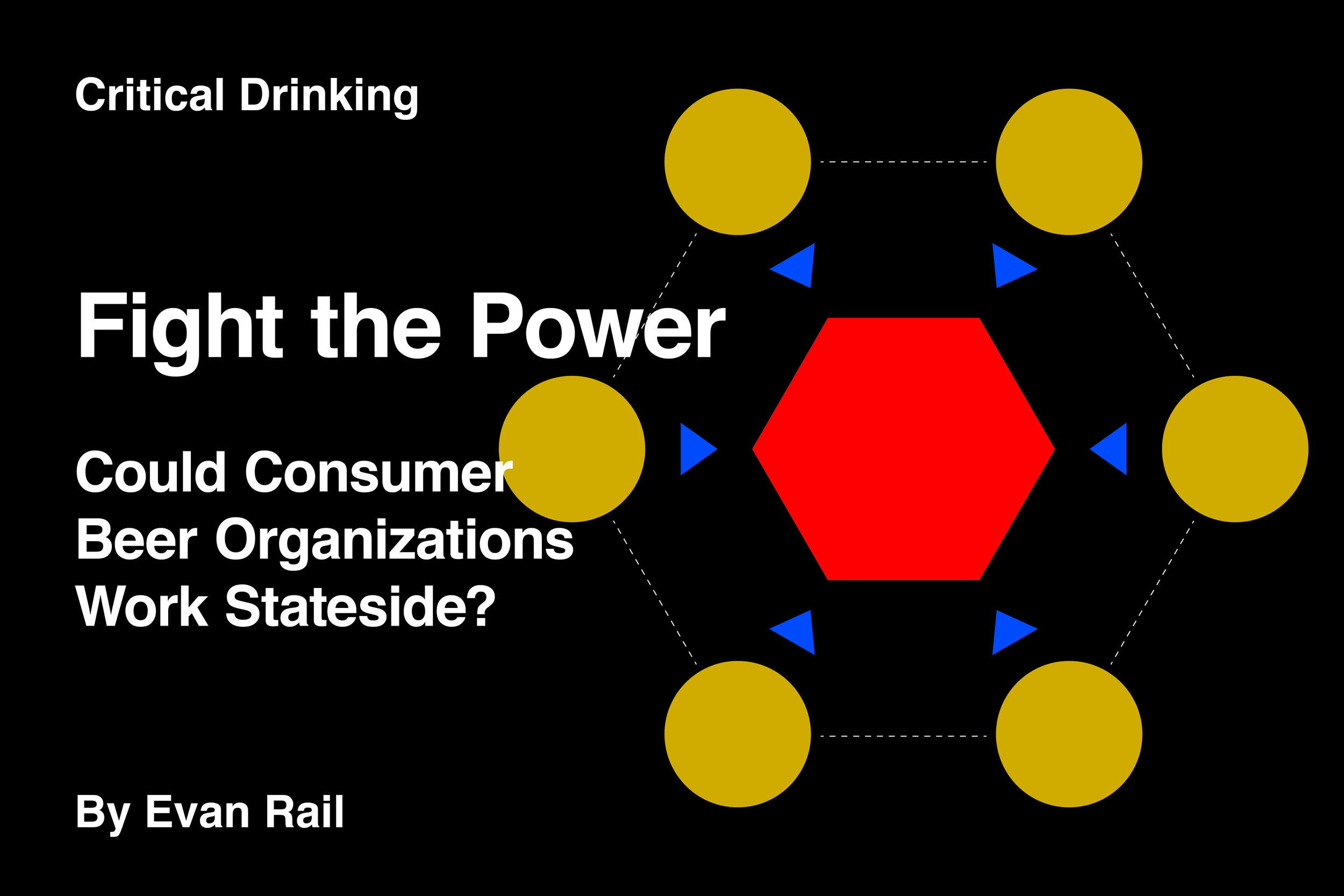Dysfunctional public transportation. Personal bankruptcies due to routine illnesses. Scorn for intellectuals. Living outside the U.S. often makes you look back home and wonder why things gotta be like that—including beer culture. For most of my beer-loving friends and family back in the States, the fight for better brews is usually presented as a black-and-white, good vs. evil scenario. On one side are small breweries and the Brewers Association. On the other side stands Megabrew. In this simplified duality, if consumers want good beer, there’s only one side we should be on.
The only problem? Consumers are not the intended beneficiaries of the Brewers Association’s efforts. The BA is an industry association, not a consumer organization, and it works to promote the interests of its members—not the interests of consumers. In that way it’s a lot like the Cattlemen’s Association, to pick one example, which lobbies on behalf of the beef industry, and which is understandably unlikely to promote a consumer-oriented angle that runs contrary to its interests, like the fact that eating lots of red meat increases the risk of disease.
Just as with streetcars, universal health insurance, paid maternity leave, and cool movies that somehow aren’t based on comic books, Americans can learn a lot about their favorite beverage by looking to the Old World. In Europe, more than 20 consumer beer organizations are working to represent the interests of actual drinkers, rather than the breweries who sell beer to them.
Often, that puts these consumer organizations on the same side as small, independent breweries, fighting against the industrial giants. Other times, a consumer organization will find itself lined up against both groups of brewers. Other times still? All three are on the same side. In any case, a look at these beer consumer groups and what they’re doing can give American beer lovers something to think about, and offer a possible roadmap for where America’s beer culture might be headed in the future.
“I find that in 90%, maybe 95% of what we’re doing, we’re aligned in our goals, because both brewers and beer consumers want to defend the beer culture,” says Henri Reuchlin, chairman of the European Beer Consumers Union (EBCU), speaking by phone from his home in the Netherlands. I’ve asked about how a consumer organization like his can end up locking horns with beer producers. “That might be even more true for smaller brewers than for large brewers.”
The EBCU is a special case, since its focus spans all of Europe, and because it currently counts 18 country-specific beer-drinkers’ organizations as its own members. It includes some 185,000 members of the Campaign for Real Ale, or CAMRA, the world’s largest and most famous beer consumer organization, as well as 80 members of Bractwo Piwne in Poland, and around 1,000 members of Sdružení Přátel Piva in the Czech Republic. Taken together, these thousands of members spread across Europe give the EBCU leverage when it comes to lobbying for European Union laws that will benefit consumers. Among the main issues the EBCU is trying to address: improved labeling standards.
“There are basically two labeling issues. One is that it’s still not obligatory to label what exactly is in your beer, EU-wide,” Reuchlin explains. “The other thing is, where does the beer come from? Who makes it? Does it make sense to say your beer is from Bremen, for instance, when it’s actually brewed in Seville? Or you buy what looks like a typical Belgian beer, but all of a sudden it seems to be brewed in Poland?”
Clearly listing the brewery of origin is a beer-drenched dream for consumers in countries like Belgium, where the country’s roughly 245 real breweries are dwarfed by an even greater number of so-called “beer firms,” which have their beers brewed under contract without ever owning any fermenters, kegs, trucks, or anything beyond a marketing plan and a computer with a copy of Adobe Illustrator.
“Does it make sense to say your beer is from Bremen when it’s actually brewed in Seville? Or you buy what looks like a typical Belgian beer, but it seems to be brewed in Poland?”
Reuchlin is gentle and avuncular in person, and he likes to say that he’d rather discuss differences among friends than among enemies. But he acknowledges that this kind of clear labeling is one place where the EBCU and beer producers don’t always have the same goals.
“I think the brewers associations are a little more hesitant to saying exactly where the beer is from, because it can limit the marketing of the beer,” he says. “And this can also affect the smaller breweries as well.”
While the all-volunteer EBCU team operates at a European level, at least 20 beer consumer organizations are currently working in at least 18 countries across Europe. (There are two different beer consumer groups in both Italy and Spain, all four of which are members of EBCU, and several as-yet-unaffiliated organizations.) With different constituencies, cultures, languages, and local laws, these different groups often have different country-specific goals, though all share an emphasis on greater consumer choice, lower prices, and better information.
In Denmark, Danske Ølentusiaster “is most concerned about the current clash between the big brewers and the small brewers,” writes Christian Andersen, press representative for the country’s 9,000-member organization. Andersen also notes that his group expects the battle to get worse in the near term, with some small breweries being forced to close and the overall beer variety and quality of the Danish market suffering as a result. In the Netherlands, PINT (Promotie Informatie Traditioneel Bier) helped to resuscitate the Dutch style of Bokbier, which was once just about extinct. And in Ireland, a relatively new group is trying to push back against a law that that is actually meant to raise prices for consumers.
“At present, Beoir is mainly concerned with the demonization of alcohol by neo-prohibitionists,” writes Reuben Gray, chairman of the Irish organization, noting his group’s opposition to a law that would introduce “ridiculous” minimum unit prices for alcohol. When I reach out for more detail, Gray directs me to contact fellow Beoir founder John Duffy, well-known for his blog, the Beer Nut.
“Minimum unit pricing will push up the prices of all alcohol, which is bad for consumers,” Duffy says, speaking on the phone from Dublin. “The importers are also saying that the requirement for Ireland-specific labeling means that they will have to reduce the range of products that they import, which would reduce consumer choice.”
“Minimum unit pricing will push up the prices of all alcohol, which is bad for consumers.”
Unfortunately, he notes, that law looks set to pass, with Beoir offering some of the most substantial opposition to it, as Irish politicians appear reluctant to challenge anti-alcohol propaganda. But in addition to fighting the good fight, Beoir is helping to push for another proposed law that will finally legalize brewery taprooms in Ireland—a clear case of “you win some, you lose some”—and offers a consumer-friendly directory of Irish beer brands, including contract-brewed beers, on its website, listing the brewery of origin whenever available.
Beoir only launched in 2010, which means it’s relatively young amongst its colleagues: PINT in the Netherlands was founded in 1980, while CAMRA dates all the way back to 1971. As such, Duffy says, being part of EBCU helped Beoir get up to speed.
“It gives us access to experienced campaigners, many of whom are facing the same issues that we are,” he says. “And it also gives us an international profile as well, in that we’re not just speaking for the beer drinkers of Ireland.”
A few of the consumer groups were born out of opposition to change, like CAMRA, which was founded to promote the then-dying style of cask-conditioning it promoted as “real” ale. (Incidentally, CAMRA was recently asked by some of its members to position itself as advocating for all beer and cider drinkers, not just cask ale fans, a modernization measure which, somewhat unsurprisingly, did not pass a recent membership vote.) Other groups actually thrive on change, like the Czech Republic’s Sdružení Přátel Piva (SPP), or Union of Friends of Beer, which came to life as a political party in 1990, fielding candidates for parliamentary elections during the anything-goes era just after the Velvet Revolution. After later transforming into a consumer organization, SPP has been involved in the discussion about the possible privatization of state-owned Budvar (sometimes called the “original” Budweiser), questioning the practice of brewing Pilsner Urquell under license in Poland and Russia (which recently ended), as well as helping to defeat an EU increase on beer tax in 2006.
Other consumer groups not yet included in the EBCU are forming or have formed in Slovenia (with a population of 2.07 million) and Malta (with 450,000 citizens). Once these new organizations become active locally, they’re usually invited to join the EBCU, and thus contribute to the pan-European fight for good beer. Slovenia has about as many people as New Mexico, and Malta is nearly as populous as Wyoming. All of which begs the question: could something similar ever happen in the U.S.?
“Because the U.S. consumer movement has kind of a puritanical streak to it, it’s not really going to push for alcoholic beverages,” says Robert Mayer, professor of family and consumer studies at the University of Utah, when asked about existing consumer groups in the U.S. “Maybe for nutrition, or for labeling, but not for beer itself.”
That hands-off tendency for alcohol means that American beer consumers would probably have to be represented by an entirely new group, rather than an established organization like the Consumers Union, which has been testing products, advocating for consumers, and conducting investigative journalism since 1936. If a new American beer consumers organization followed the European model, it could be based on an alliance of smaller, state-specific or regional groups. But that model was created decades back, and new methods of communication mean there are new ways to get things done.
“What you’re looking for nowadays are people who are able to network quickly, who are able to organize quickly, who are able to get comments out quickly, and generally do things in a modern way,” says Tim Webb, a lifelong CAMRA member and part of the EBCU’s executive committee. “That’s the ideal. The potential for what beer consumer groups can do is enormous.”
“Because the U.S. consumer movement has kind of a puritanical streak to it, it’s not really going to push for alcoholic beverages. Maybe for nutrition, or for labeling, but not for beer itself.”
To start, that might include a demand for clear, consumer-friendly date labeling on beer cans and bottles, something that doesn’t seem to be a priority for the Brewers Association. (Which, again, is working in the interests of its brewer members, not consumers.) Or, if an erratic government suddenly proposes a new tariff on imported aluminum, for instance, a consumer group could talk about potential problems from the perspective of those who will probably be most affected in the end, since brewers, canners, and suppliers are likely to simply to pass on any extra cost in the form of higher prices.
“You’ve got issues where all the stakeholders have a financial interest in the final outcome, with the exception of the consumers,” Webb says. “This independent wedge, used properly, is very powerful. Consumers can say, ‘No, no, no—just from the outside looking in, this is the way you’ve got to do it.’”
One of the main issues facing any consumer group, Mayer notes, can be the question of securing funding, noting that many industries actually provide consumer groups with financial support.
“Maybe a good analogy would be organic food, where a lot of the consumer organizations are supported by organic food growers,” Mayer says. Writing later in an email, Mayer adds a follow-up: “Consumer organizations need to have a ‘funding model’ if they are going to survive for very long, let alone thrive.” Other U.S. consumer groups, he says, support themselves by hosting conferences, or by selling publications, like the non-profit Consumers Union does with its Consumer Reports.
Or, as with the EBCU and the country-specific groups in Europe, the money to do good work could come from member dues. Whatever the means of funding, if the U.S. ever did have a beer consumers’ group, it would mean that drinkers finally wouldn’t be forced to align themselves with trade organizations like the Brewers Association—and the even larger Beer Institute—organizations which aren’t even supposed to be looking out for their interests.
Instead, issues like those called out in a recent Fervent Few Weekly Topic could be addressed from the consumer’s point of view. A beer consumers organization could help push for the right of production breweries in Texas, for example, to sell growlers or bottles of beer to go, effectively doubling the efforts of the brewery trade organization CraftPAC, but using that “independent wedge,” as Webb put it, to make even more of an impression on legislators. Instead of arguing that grocery stores and convenience stores have the right to sell cold beer in Indiana, it could argue for the consumer’s right to buy cold beer: an obvious benefit to the actual end-user in terms of product quality and flavor. Or it could present evidence of widespread community support for self-distribution for breweries in Louisiana—evidence that’s above and beyond the interests of the breweries themselves.
Ultimately, a beer consumers organization would be able to speak about important issues from a much more objective point of view than the Brewers Association or any other trade organization. It would mean that at least one party discussing the so-called “illusion of choice” involving industrial-brewery craft brands wouldn’t have a financial interest in the outcome—unlike many famous craft brewers, whose complaints about the same are undercut by their obvious profit motive. For beer consumer groups like the ones now working in Europe, the concern is never about profits, or about scoring points or winning. The only concern is good beer.










